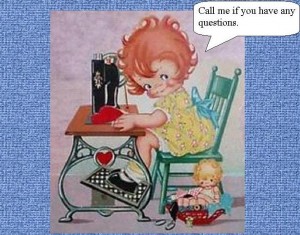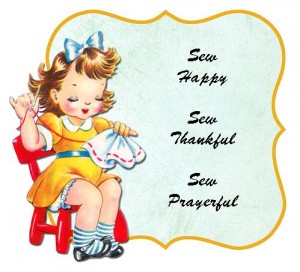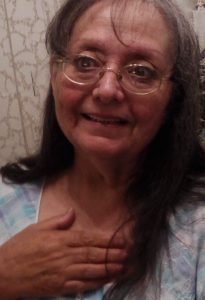Supply List For Sewing AND Quilting Class
You do NOT have to have every item to begin class. Many items are available in the classroom for your use during class time but you will want to have your own to use when you start sewing at home. Those in red are the most important to begin with. The other items can be picked up along the way. Items that have an * in front of the name are for the quilting class and not necessary for sewing classes. Also….don’t fret over this list to much. We will go over it in the first class. If you have any questions I can answer them at that time.
Blue painters tape (optional) this is great stuff. I use it to mark seam stitching lines on my machine, when I get ready to make the quilt sandwich, to make a long straight line on fabric when I don’t want to mark on it, and so very much more. It doesn’t leave a sticky residue on your fabric or machine but will normally hold until you remove it. It comes in different widths also. I recommend you having a roll in your sewing kit but it isn’t a necessity.
*Clear cutting ruler*(quilting class but can be very handy for sewing also) with measurements printed on it. Used with the rotary cutter and self healing mat. They come in all shapes and sizes. A good size to start with is 6 to 8 inches wide by 18 to 24 inches in length. You will probably add more as you go along.
*Darning or Free motion quilting foot*–(quilting class only)this foot is used when free motion quilting. Many times it comes with a new sewing machine. If not they are easily found as a generic.
*Quarter inch foot*- (quilting class only) When quilting the seam that is used is one quarter of an inch wide. This is a special presser foot that makes keeping your seams at exactly 1 quarter of an inch much easier. They do not normally come with a new machine. You can order one from the manufacturer of your machine or you can purchase a generic one, just be sure to check the package and make sure it will fit your sewing machine. Some have guides that the fabric sets against as you sew, some don’t. I personally don’t like the guides but I know many people that swear by them. You can buy one with the guide and if you don’t like it then you can just pop it off like I did.
Marking tool of some sort. i.e. Chalk, erasable fabric pencil, disappearing ink and a regular pencil is very handy
Measuring Tape-cloth or plastic
Needles— 2 types
You’ll want extra needles for your sewing machine and
Hand sewing needles (small variety pack) for basting, hemming, small repairs, closing openings, attaching the binding, etc.
Needle threader (optional)—there are 2 kinds. One that is hand held and has a small wire loop you push in the eye of the needle to place your thread in and pull back through. The other one is a little machine, you place your needle in it and the thread lays across an indentation then you push a little lever and it threads the needle. I have them but don’t usually have to use them. It really depends on if you have a difficult time threading your needles.
Pincushion—your choice of size, style etc. I don’t use magnetic pincushions because I don’t want them around my computerized sewing machine. I’ve heard that they will and that the will “not” hurt the machine. I don’t know which it is and since it’s not an important thing to me I just stay away from them. I do have lots of pincushions though. Some bought and many made. I like to keep all my pins and needles separated. It’s not necessary, it’s simply a matter of personal preference.
*Quilting basting / safety pins* (quilting class only) they come in different sizes, I prefer the medium size as the very large ones will occasionally leave holes in the fabric and the smaller ones are difficult to use, especially if your batting is thick. You will need LOTS of them though…..so when in doubt buy extra. Even if you are not quilting, you might want to include in one medium sized safety pin with your sewing supplies through because they are great for turning tubes, such as those used for straps or handles.
*Rotary cutter*-(quilting class only) this is a cutting tool with a very very VERY sharp round blade. Many of them look a bit like a pizza cutter. Oh, and did I mention they are very sharp? It’s a great tool and makes cutting so much easier, faster and accurate but I can’t express enough how careful you need to be with this tool.
NOTE: They make what is called a Klutz glove that you wear to protect your hand when using the rotary cutter. I think they are a good investment, especially for a beginner or a child.
Scissors—I recommend 3 types
Fabric/dress sheers-never cut paper with these. It will dull them very quickly
Small thread snips-to be kept near your sewing machine to cut the little threads. I keep mine on a lanyard around my neck otherwise I seem to loose them every few minutes.
Paper scissors-I recommend having a designated pair of scissors just for paper. They will come in handy and if they are out an available no one will be tempted to use your good fabric scissors.
Seam gauge-I use this tool a lot. They are not expensive and yet very handy.
Seam ripper–seam rippers come in different sizes, colors and price ranges. Many times one will come with your sewing machine. I recommend getting a couple of mid price range. You don’t need a fancy one but they seem to get lost on the sewing table easily (so buy a couple). Helpful hint- the cheaper ones do seem to get dull very quickly.
*Self healing rotary cutter mat*(quilting class only)—they are a bit expensive but you will save money if you buy a larger sized one from the beginning. So many people buy a smaller one to find out they just have to turn around and invest in a larger one very quickly. Using the 40 or 50% off coupons from Joanne’s help a lot on items like this.
Sewing machine in good working order with extra bobbins. I won’t recommend a brand but just be aware that if you will be “quilting” you need a sewing machine that can handle 3 thicknesses of material. You may not be able to purchase the most expensive but there are many good machines in the mid price range. You will probably get a couple of bobbins when you buy your machine. Later on you will want to pick up a few more. BE VERY CAREFUL – check the model number listed on the bobbin package to make sure it is made for your machine. Just because they look like those that came with your machine or have the same brand name on the package (i.e. Singer)is no guarantee that they will work well in your machine. Close is not good enough where bobbins are concerned. Attempting to sew using the wrong bobbin, no matter how close they look, will cause you major headaches every time.
Straight pins—there are many different types so read the package carefully and get what you want depending on what you will be using them for. I have and use a variety but keep them all separate. I like the long thin dress maker pins for normal sewing. I use very thin tiny glass headed pins for delicate fabric. I use the thicker long pins with flat heads for quilting. They come with different shaped flat heads, flowers, moons, hearts, etc. Just remember that you will be pressing a lot and some of these heads are plastic and will melt. Check the package and try to get the ones that say heat resistant. They also make ones with large round heads called quilter pins that are most common for quilting. As you try different ones you will decide which are your favorites for each job.
Thimble—I know, so many people say they don’t like to use them but really, they are not expensive and once you adjust to sewing with one on you will wonder why you waited to purchase it. They really do protect your finger and if you decide to hand quilt you will need 2. One for the hand that is sewing the other for the hand that is under the quilt. Also, try a few different types. There are many and everyone has their favorite style and brand.
Thread—I recommend that you start with 3 spools
White, beige and black. You can add more colors as you go along. Also, don’t use bargain thread from the dollar store. It causes lots of problems with your machine. Many times when a person thinks there is something wrong with their sewing machine the cause is cheap thread. You will save yourself lots of headaches if you just buy the better brand. Also, don’t buy quilting thread unless you are hand quilting. It’s heavier, stronger, thicker and doesn’t work well in many machines.
*Walking Foot*-(optional)(quilting class only)this is a special foot that is used in quilting. It keeps the top material moving with the bottom fabric so there are no bunches, bubbles or folds when you’re done stitching. You will have to purchase them separately as they do not normally come with new machines. Again, check carefully and make sure the one you buy will fit your machine. You will need one that fits a high shank, low shank, snap on or slant foot depending on your sewing machine.
Zipper Foot– normally this comes as standard accessory with a new sewing machine. If you purchased a used machine or one was passed on to you check to see if you have one. Remember….all machines are different so the zipper foot you purchase will have to fit the make and model of your machine. They are not interchangeable from one machine to another. The zipper foot is not only used for installing zippers but can be used for piping.
BTW, you will need one for Lesson #6 in the beginners sewing class so you’ll want to make sure you have one before that class.
Your sewing tools/notions are an investment. You will need a container to place them in. It doesn’t have to be anything fancy, just something to keep them all together and safe.
[button link="http://www.bizzyhandz.com/wordpress/" target="_self" color="red" shape="circle" size="large”]HOME[/button]

 1-702-281-4854
1-702-281-4854


